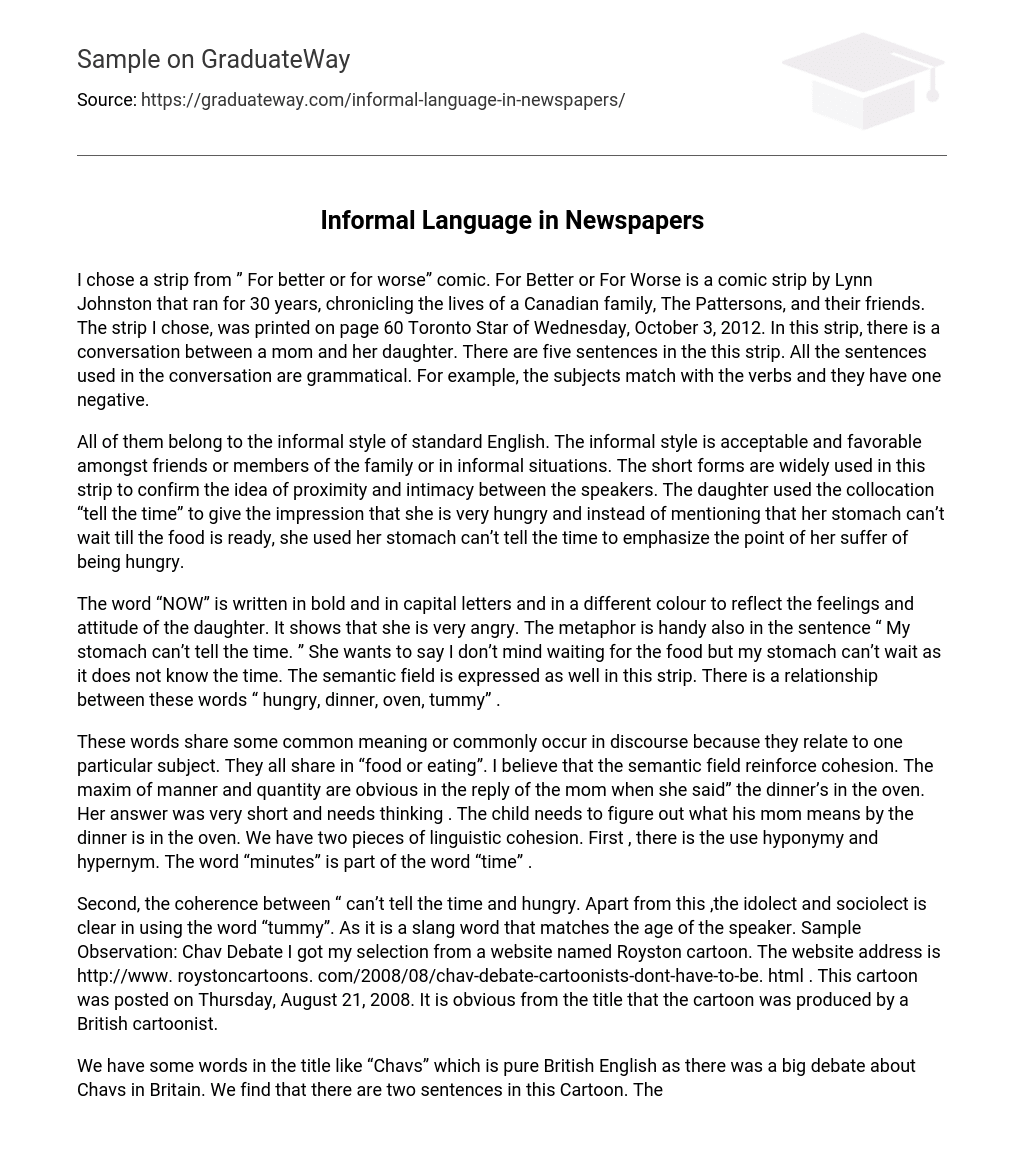I chose a strip from ” For better or for worse” comic. For Better or For Worse is a comic strip by Lynn Johnston that ran for 30 years, chronicling the lives of a Canadian family, The Pattersons, and their friends. The strip I chose, was printed on page 60 Toronto Star of Wednesday, October 3, 2012. In this strip, there is a conversation between a mom and her daughter. There are five sentences in the this strip. All the sentences used in the conversation are grammatical. For example, the subjects match with the verbs and they have one negative.
All of them belong to the informal style of standard English. The informal style is acceptable and favorable amongst friends or members of the family or in informal situations. The short forms are widely used in this strip to confirm the idea of proximity and intimacy between the speakers. The daughter used the collocation “tell the time” to give the impression that she is very hungry and instead of mentioning that her stomach can’t wait till the food is ready, she used her stomach can’t tell the time to emphasize the point of her suffer of being hungry.
The word “NOW” is written in bold and in capital letters and in a different colour to reflect the feelings and attitude of the daughter. It shows that she is very angry. The metaphor is handy also in the sentence “ My stomach can’t tell the time. ” She wants to say I don’t mind waiting for the food but my stomach can’t wait as it does not know the time. The semantic field is expressed as well in this strip. There is a relationship between these words “ hungry, dinner, oven, tummy” .
These words share some common meaning or commonly occur in discourse because they relate to one particular subject. They all share in “food or eating”. I believe that the semantic field reinforce cohesion. The maxim of manner and quantity are obvious in the reply of the mom when she said” the dinner’s in the oven. Her answer was very short and needs thinking . The child needs to figure out what his mom means by the dinner is in the oven. We have two pieces of linguistic cohesion. First , there is the use hyponymy and hypernym. The word “minutes” is part of the word “time” .
Second, the coherence between “ can’t tell the time and hungry. Apart from this ,the idolect and sociolect is clear in using the word “tummy”. As it is a slang word that matches the age of the speaker. Sample Observation: Chav Debate I got my selection from a website named Royston cartoon. The website address is http://www. roystoncartoons. com/2008/08/chav-debate-cartoonists-dont-have-to-be. html . This cartoon was posted on Thursday, August 21, 2008. It is obvious from the title that the cartoon was produced by a British cartoonist.
We have some words in the title like “Chavs” which is pure British English as there was a big debate about Chavs in Britain. We find that there are two sentences in this Cartoon. The title and the one – way conversation from the lady. The title is a standard English and grammatical and formal except the use of the contraction from of “ don’t” There is a linguistic cohesion between the words and the characters in the pictures. The word “ Chav” is illustrated in the way the two characters are wearing including the baseball cap the man is wearing.
This shows that these two people are from the working class. The other example of cohesion is the language used by the speaker and the way she was wearing. Moreover, the link between the word “muffin top” and the way the lady appears. The point of non standard language is clear in the sentence mentioned by the lady. She used the short forms of words, the two negatives as she wants to be emphatic and also denies the whole idea i. e. the word muffin top and even the dictionary. However, it is partially grammatical, it has an ungrammatical sentence. She said” I am not never heard of that. However ,it should be “ I have never heard of that. ” On the other hand, the other sentence, “what is it? ” is grammatically correct .
This cartoon also introduces the new meaning of “muffin top” as a collocation to refer to the people who are having excess fat around their waist. Along with that, this means that language is dynamic or in other words there are always new words in language. The sociolect is illustrated here as well, we can see the way how the words were uttered like ‘heard, what is it, dictionary” highlighted that some of the working class people share the same idolect.





